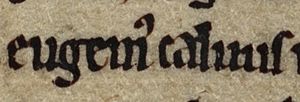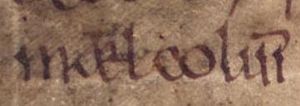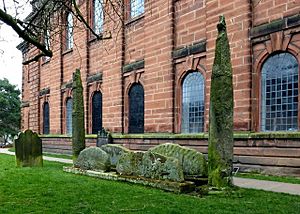Owain Foel facts for kids
Quick facts for kids Owain Foel |
|
|---|---|

Owain Foel's name as it appears on folio 94v of Cambridge Corpus Christi College 139 (Historia regum Anglorum).
|
|
| King of Strathclyde | |
| Predecessor | Owain ap Dyfnwal |
| Issue | possibly Máel Coluim |
| Father | possibly Máel Coluim |
Owain Foel (meaning he was active around 1018), also known as Owain the Bald, was a king of Strathclyde in the 11th century. Strathclyde was a kingdom in what is now Scotland and parts of northern England.
Owain Foel might have been the son of Máel Coluim, who was also a king of Strathclyde. Owain Foel is known for helping the Scots in a big battle called the Battle of Carham in 1018. We don't know exactly when he died, but it's possible he died during or soon after this battle. He might also be an ancestor of another important person named Máel Coluim, who was called "son of the king of the Cumbrians" around the 1050s.
Owain Foel's Family Tree
Owain Foel was part of the royal family that ruled the Kingdom of Strathclyde. For a long time in the 900s, the kingdom was led by Dyfnwal ab Owain, King of Strathclyde. He seems to have stopped being king around the 970s.
His son, Máel Coluim, became king in 973. After Máel Coluim died in 997, another king named Owain ap Dyfnwal took over. He was likely another son of Dyfnwal.
| Simplified pedigree of the Cumbrian royal dynasty. Owain Foel is highlighted. It is possible that all these men ruled the Kingdom of Strathclyde. | |||||||||||||||||||||||||||||||||||||||||||||||||||||||||||||||||||||||||||||||||||||||||||||||||||||||||||||||||||||||||||||||||||||||||||||||||
|---|---|---|---|---|---|---|---|---|---|---|---|---|---|---|---|---|---|---|---|---|---|---|---|---|---|---|---|---|---|---|---|---|---|---|---|---|---|---|---|---|---|---|---|---|---|---|---|---|---|---|---|---|---|---|---|---|---|---|---|---|---|---|---|---|---|---|---|---|---|---|---|---|---|---|---|---|---|---|---|---|---|---|---|---|---|---|---|---|---|---|---|---|---|---|---|---|---|---|---|---|---|---|---|---|---|---|---|---|---|---|---|---|---|---|---|---|---|---|---|---|---|---|---|---|---|---|---|---|---|---|---|---|---|---|---|---|---|---|---|---|---|---|---|---|---|
|
|||||||||||||||||||||||||||||||||||||||||||||||||||||||||||||||||||||||||||||||||||||||||||||||||||||||||||||||||||||||||||||||||||||||||||||||||

Old records from the 11th to 13th centuries say that Owain ap Dyfnwal was killed in 1015. This is supported by other historical writings. Even though these records suggest he died in battle, we don't know the details.
It's important to note that Owain Foel lived years after 1015. This means he was likely a different person from Owain ap Dyfnwal. If they were different, they were probably close relatives. Owain Foel might have been the son of Owain ap Dyfnwal's brother, Máel Coluim. Having two kings named Owain at the same time could explain why Owain Foel was given the nickname "the Bald."
The Battle of Carham
In 1005, Máel Coluim mac Cináeda became the King of Alba (Scotland). One of his first actions as king was to attack the English kingdom of Northumbria. However, this attack was stopped by a brave young leader named Uhtred. He became the Earl of Northumbria for his strong defense.
Later, the English king's power weakened because of attacks from Vikings. Eventually, Knútr Sveinnsson became king of all England in 1016.
The trouble in northern England might have encouraged Máel Coluim mac Cináeda to attack again. This time, Owain Foel joined the Scots. He might have been an ally or a ruler who worked under the Scottish king.

This invasion led to the Battle of Carham in 1018. The Scots and Owain Foel's forces fought and defeated the English at Carham. Many old sources mention this battle, and the 12th-century book Historia regum Anglorum specifically says Owain Foel was there.
There's some debate about who led the English forces. Historia regum Anglorum says it was Uhtred. However, another old text, the Anglo-Saxon Chronicle, suggests Uhtred might have died two years earlier. So, it might have been Uhtred's brother, Eadwulf Cudel, who led the English troops.
The English defeat at Carham helped the Scots gain control over a region called Lothian. It also set the River Tweed as the southern border of their kingdom. For Owain Foel and the people of Strathclyde, winning the battle likely meant they got a lot of valuable things, like cattle and other goods. It's also possible that the Kingdom of Strathclyde grew bigger because of this victory.
For example, a survey from the 12th century about the lands of the Bishop of Glasgow suggests that a region called Teviotdale, which used to be English, might have become part of Strathclyde after the Battle of Carham.
Owain Foel's Death and Strathclyde's Decline
We don't know exactly when Owain Foel died. He might have died in the Battle of Carham or soon after, but there's no clear proof. He could have lived and ruled for many more years.
It's possible that after Owain Foel died, the Scottish king, Máel Coluim mac Cináeda, took control of Strathclyde. If this happened right after Carham, it would have been when the Scottish king was very powerful. Owain Foel might have died before 1030, possibly leaving no strong heir to the throne. In 1030, old records say that the English and Vikings from Dublin attacked the Britons (people of Strathclyde).
Another event that tells us about Strathclyde's fate happened around 1031. The Anglo-Saxon Chronicle mentions a meeting of kings: Knútr, Máel Coluim mac Cináeda, Mac Bethad mac Findlaích, and Echmarcach mac Ragnaill. The important thing is that no king from Strathclyde was at this meeting. This might mean that by 1031, Strathclyde no longer had its own king and was part of the Scottish kingdom. The reason for this meeting is unclear, but it might have been about the fall of Strathclyde.

There's also a record of the death of Suibne mac Cináeda, who was called "King of the Gall Gaidheil". The Gall Gaidheil were a group of people with mixed Viking and Gaelic (Scottish/Irish) backgrounds. They first appeared in the 800s. Their original home was near the Firth of Clyde in Scotland. Over time, they expanded into areas that used to be controlled by Strathclyde. This expansion might be linked to the decline of the Kingdom of Strathclyde in the 11th century. Suibne might have been a leader who helped bring about the end of Strathclyde's rule and took over its western lands.
Suibne's father's name was Cináed, just like Máel Coluim mac Cináeda, the Scottish king. This might mean they were brothers. If so, Máel Coluim might have taken over Strathclyde and put Suibne in charge of the Gall Gaidheil in that area. This could explain why the Scots didn't immediately take advantage of their victory in 1018. Instead, they might have focused their efforts on taking over the weaker Strathclyde kingdom.

An old prophecy from the 12th century called Máel Coluim mac Cináeda the "enemy of Britons." We don't know if this means he truly disliked the people of Strathclyde. It might refer to attacks against them after the Battle of Carham and Owain Foel's death. In 1038, another English leader, Eadwulf of Bamburgh, attacked some Britons. This could mean some people of Strathclyde were still independent, or they might have been under the control of the Gall Gaidheil when attacked.
Owain Foel might have lived until the 1050s. In 1054, Siward, Earl of Northumbria, invaded Scotland and defeated King Mac Bethad. Two 12th-century books say that Siward put a man named Máel Coluim on the throne. This Máel Coluim was identified as the son of the king of the Cumbrians. He was likely part of the Strathclyde royal family, perhaps a son or grandson of Owain Foel.
If this Máel Coluim was related to Owain Foel, it's possible the Scots had taken the Strathclyde kingship from him after Owain Foel died. Then, Siward might have put him back as king of Strathclyde after defeating Mac Bethad. Another idea is that Siward made Máel Coluim the King of Alba (Scotland). If Máel Coluim became King of Alba, then Owain Foel might still have been ruling Strathclyde at that time.
Whatever the exact details, Owain Foel is the last known king of Strathclyde.





